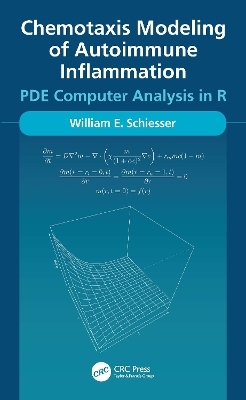
Chemotaxis Modeling of Autoimmune Inflammation
CRC Press (Verlag)
978-1-032-31764-9 (ISBN)
In response to an infection (e.g., from pathogens such as bacteria and viruses), the immune system can deplete macrophages (specialized white blood cells) and produce cytokines that are pro-inflammatory or anti-inflammatory. This counterproductive autoimmune response is represented mathematically as nonlinear chemotaxis diffusion.
This book is directed to the computer-based modeling of chemotaxis inflammation. The spatiotemporal analysis is
based on a model of three partial differential equations (PDEs).
The three PDE model is coded (programmed) as a set of routines in R, a quality, open-source, scientific programming system. The numerical integration (solution) of the PDEs is by the method of lines (MOL).
The three PDE model can be used for computer-based experimentation, for example, parameter variation and changes in the model equations or alternate models, to enhance a quantitative understanding of a postulated
inflammation.
This experimentation is illustrated by chapters pertaining to: (1) the computation and display of the PDE time derivatives, (2) the RHS terms of the PDEs with emphasis on the chemotaxis terms, (3) parameter variations to demonstrate parameter effects and sensitivities and (4) additonal terms in the PDEs to include PDE coupling and extensions of the basic PDE model.
William E. Schiesser is Emeritus McCann Professor of Computational Biomedical Engineering, Chemical and Biomolecular Engineering and Professor of Mathematics at Lehigh University. His research is directed toward numerical methods and associated software for ordinary, differential-algebraic and partial differential equations (ODE/DAE/PDEs), and the development of mathematical models based on ODE/DAE/PDEs. He is the author, coauthor or coeditor of 30+ books, and his ODE/DAE/PDE computer routines have been accessed by thousands of colleges and universities, corporations and government agencies.
1. PDE Chemotaxis Model Formulation. 2. PDE Chemotaxis Model Implementation. 3. Analysis of the Chemotaxis Model Time Derivatives. 4. Analysis of the Chemotaxis PDE Model Terms. 5. Sensitivity Analysis of the Chemotaxis. 6. Extensions of the Three PDE Chemotaxis Model. 7. Functions dss004, dss044. 8. Accuracy of Numerical PDE Solutions.
| Erscheinungsdatum | 11.07.2023 |
|---|---|
| Zusatzinfo | 13 Tables, black and white; 47 Line drawings, black and white; 47 Illustrations, black and white |
| Verlagsort | London |
| Sprache | englisch |
| Maße | 156 x 234 mm |
| Gewicht | 280 g |
| Themenwelt | Mathematik / Informatik ► Mathematik ► Angewandte Mathematik |
| Medizin / Pharmazie ► Physiotherapie / Ergotherapie ► Orthopädie | |
| Studium ► Querschnittsbereiche ► Infektiologie / Immunologie | |
| Naturwissenschaften ► Biologie | |
| Technik ► Medizintechnik | |
| Technik ► Umwelttechnik / Biotechnologie | |
| ISBN-10 | 1-032-31764-7 / 1032317647 |
| ISBN-13 | 978-1-032-31764-9 / 9781032317649 |
| Zustand | Neuware |
| Informationen gemäß Produktsicherheitsverordnung (GPSR) | |
| Haben Sie eine Frage zum Produkt? |
aus dem Bereich


